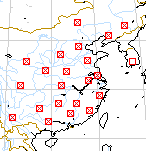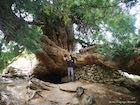Conservation Status

Platycladus orientalis
(Linnaeus) Franco 1949
Common names
Chinese or oriental arborvitae; 侧柏 ce bai [Chinese]; コノテガシワ [Japanese].
Taxonomic notes
The sole species in the genus Platycladus Spach 1842 (syn. Biota D. Don ex Endlicher). As detailed by Farjon (2005), its closest relative is Microbiota, with both genera only distantly related to Thuja, where Linnaeus originally placed this species (and some horticulturalists continue to place it).
Synonymy (Fu et al. 1999):
- Biota orientalis (Linnaeus) Endlicher;
- Thuja orientalis Linnaeus 1753;
- Platycladus stricta Spach;
- Thuja chengii Bordëres et Gaussen;
- T. orientalis var. argyi Lemèe et H. Lèveillè.
Description
Monoecious evergreen trees to 20 m tall and 100 cm dbh. Bark red-brown to light grey-brown, thin, flaking in long strips. Crown ovoid-pyramidal when young, broadly rounded or irregular when old. Branchlets arranged in a plane, spreading or ascending, flattened. Leaves decussate, 4-ranked, scalelike, base decurrent, 1-3 mm long, apex bluntly pointed, with an abaxial resin gland, dimorphic along branchlets; lateral leaves overlapping facial ones, boat-shaped, ridged, apex slightly incurved, without conspicuous, white stomatal bands abaxially but with a median groove. Facial leaves rhomboid, with a conspicuous, linear, glandular groove at center abaxially. Pollen cones with 8-12 microsporophylls, each with 3-6 pollen sacs; yellowish green, ovoid, 2-3 mm long. Seed cones terminal, solitary, dehiscent when mature in first year, when immature bluish green, subglobose, ca. 3 mm in diameter, when ripe red-brown, subovoid, 1.5-2(-2.5) × 1-1.8 cm; cone scales 6 or 8, decussate, flat, thick, woody, only the middle 2 pairs fertile (proximal 2 fertile cone scales 2-seeded, distal 2 fertile scales 1-seeded); free bract apex a long, recurved cusp. Seeds wingless, rarely with a very narrow wing, grey-brown or purple-brown, ovoid or subellipsoid, 5-7 × 3-4 mm, slightly ridged. Cotyledons 2. Pollination March to April, seed maturity October (Fu et al. 1999).
Distribution and Ecology
Korea, E. Russia, and China. Farjon (2005) describes this as "the most widely introduced cupressaceaous conifer in Asia," with the result that naturalized populations are very widely distributed. It is likely native in S Gansu, Hebei, Henan, Shaanxi, Shanxi, and perhaps Sichuan. Naturalized populations are known in Austria, Belgium, Bulgaria, China, Colombia, Croatia, Czechia, France, Greece, Hungary, India, Italy, Japan, Kazakhstan, Mexico, Moldova, Netherlands, Portugal, Russia, Serbia, Slovakia, Spain, Switzerland, Turkey, Ukraine, United Kingdom, United States, and Uzbekistan. Occurs at 300-3,300 m. elevation (Fu et al. 1999). Hardy to Zone 6 (cold hardiness limit between -23.2°C and -17.8°C) (Bannister and Neuner 2001).
Remarkable Specimens
A tree in Nasreddinabad, Tajikistan, is 35 m high and 14 m dbh (Vladimir Dinets e-mail 1998.01.10). The specimen shown here, from Uzbekistan, is accompanied by a sign stating its girth at 24 m, girth of the central trunk at 12 m, and height at "more than 20 meters." It is also said to have been planted by soldiers of Alexander the Great, which seems most improbable as this tree is at least 30 degrees of longitude west of the westernmost natural populations, while this was about the easternmost point attained by Alexander. It certainly appears very old, though. Ages of some cultivated trees in the Beijing (China) area are said to exceed 1000 years (Silba 1996).
Ethnobotany
Observations
Remarks
"It is common tree of China, and some relic populations exist in Central Asia (it is often said that they are all along The Great Silk Road and aren't natural, but there are also some very old trees in remote mountain areas" (Vladimir Dinets e-mail 1998.01.10).
When Linnaeus erected the genus Thuja, he recognized a "western Thuja" (T. occidentalis of North America) and this, the "eastern Thuja" of Asia. The two species are now known to be only very distantly related, but Linnaeus' epithet persists.
Parrots (several species) in New South Wales eat the seed cones of ornamental plants. I learned this on iNaturalist in December 2024 when user "Pratyeka" sent me links to a several observations of birds engaged in this behavior.
Citations
Franco. 1949. Portugaliae Acta Biol., ser. B, Sist. Vol. "J'lio Henriques": 33.
Missouri Botanical Garden. 2001. TROPICOS database, accessed 2001.06.30. http://www.mobot.org/MOBOT/TROPICOS/China/China4/N24900394.html, now defunct.
Silba, John. 1996. Noteworthy conifers in the Xian Shan region of Beijing, China. American Conifer Society Bulletin 13(1):8-12.
Spach, Rhoeadium. 1841. Histoire Naturelle des Végétaux. Phanérogames 11: 333.
See also
Elwes and Henry 1906-1913 at the Biodiversity Heritage Library (as Thuya orientalis). This series of volumes, privately printed, provides some of the most engaging descriptions of conifers ever published. Although they only treat species cultivated in the U.K. and Ireland, and the taxonomy is a bit dated, still these accounts are thorough, treating such topics as species description, range, varieties, exceptionally old or tall specimens, remarkable trees, and cultivation. Despite being over a century old, they are generally accurate, and are illustrated with some remarkable photographs and lithographs.
Farjon (2005) provides a detailed account, with illustrations.
The PROTA database account for this species (accessed 2019.02.28). PROTA accounts are focused on commercial forest uses in Africa, and typically include photographs, drawings, names, distribution, and a variety of information relevant to management of the species.
Last Modified 2025-02-22




